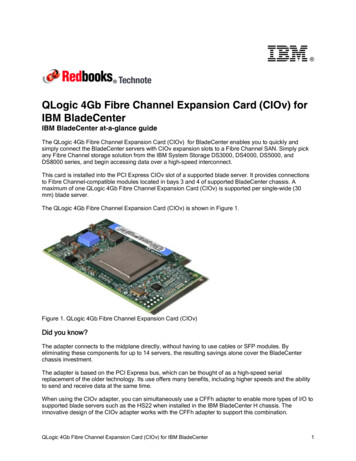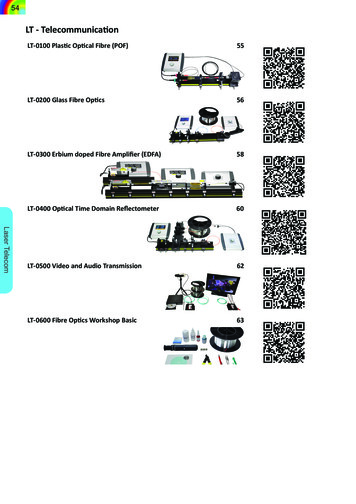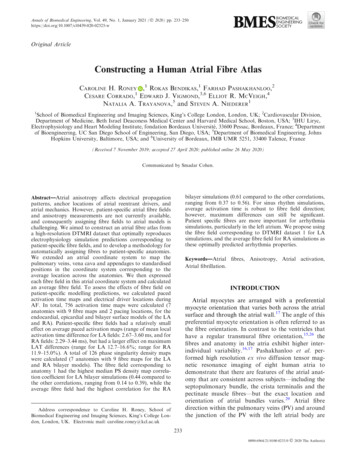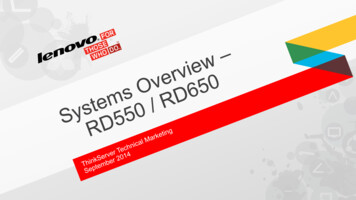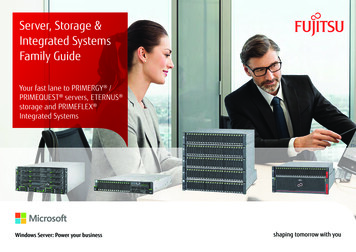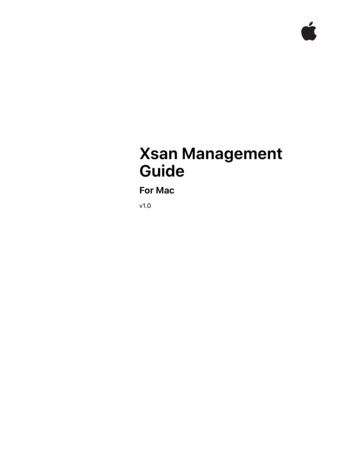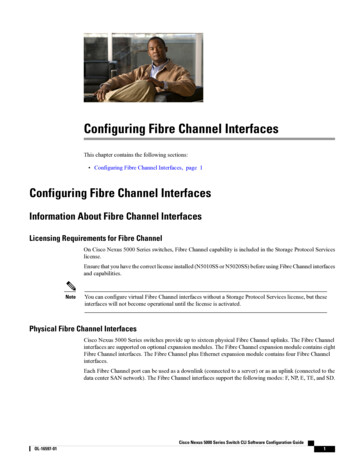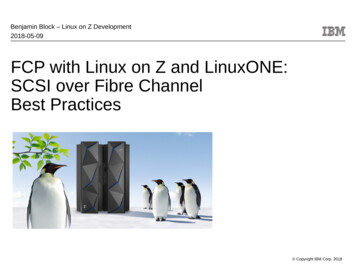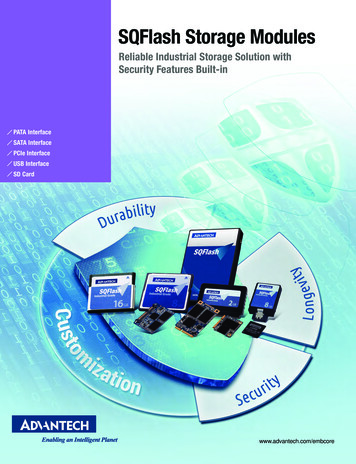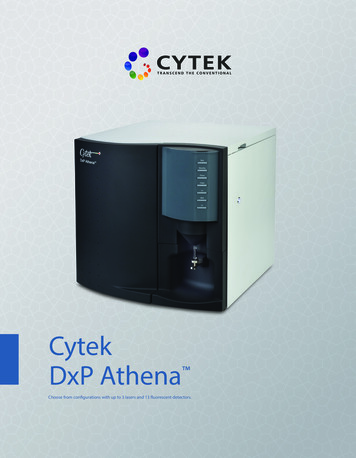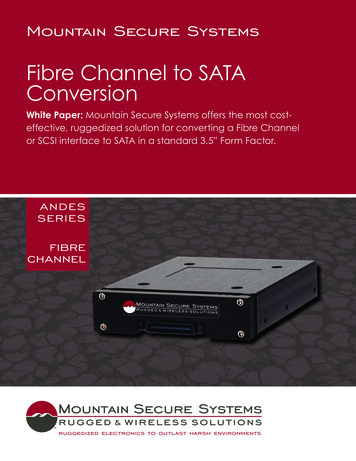
Transcription
Mountain Secure SystemsFibre Channel to SATAConversionWhite Paper: Mountain Secure Systems offers the most costeffective, ruggedized solution for converting a Fibre Channelor SCSI interface to SATA in a standard 3.5” Form Factor. ruggedized electronics to outlast harsh environments
Mountain Secure Systems Fibre Channel Conversion SolutionMountain Secure Systems offers the mostcost-effective, ruggedized solution forconverting a Fibre Channel or SCSI interfaceto SATA in a standard 3.5” Form FactorMountain Secure Systems (MSS) offers the most cost-effective solutionin the marketplace to extend the life of legacy systems that utilize FibreChannel or SCSI interfaces with its drop-in replacement conversion sled.The conversion sled mimics a 3.5” Fibre Channel or SCSI (50, 68 and 80pin) HD or SSD by integrating a standard, commercially-available 2.5”SATA HD or SSD into a 3.5” standard form factor package. Almost anydrive can be selected to best meet program requirements, includingconsiderations of HD vs. SSD, capacity, price point, environment, speed,endurance, and Single Level Cell (SLC) versus Multi-Level Cell (MLC). Thisconvenient solution reduces the effort of locating replacement end-oflife (EOL) drives, which may or may not be available, and helps avoidthe high cost of redesigning and re-qualifying the architecture of thesystem to utilize modern interfaces.MSS works directly with the leading players in interface conversion andintegrates their technology into our own rugged package. Our solutionsare designed to mitigate low frequency resonant vibration input to theHD/SSD, as well as provide an optimized path to conduct heat awayfrom the drive. MSS conversion sleds can also be matched to the weightand center of gravity (CG) of the HD/SSD being replaced, which isimportant for systems used in flight, where it is imperative that nothingchanges that would affect the original design criteria.All MSS conversion sleds aredesigned and manufacturedto meet AS9100 configurationcontrol standards and arefully-functional tested to thecustomer’s environmentalrequirements prior to delivery.In addition, MSS conversion sleds incorporate an electrical barrier thatprevents anything from shorting against the PCBA or HD/SSD. PCBAsare conformal coated to withstand moisture, sand, dust, etc. And, mostimportantly, all MSS conversion sleds are designed and manufacturedto meet AS9100 configuration control standards and are fully-functionaltested to the customer’s environmental requirements prior to delivery.Fibre Channel to SATA Embedded Storage Bridge SolutionThe MSS Andes Fibre Channel to SATA Conversion Sled provides apath to remove high-cost FC drives in favor of lower-cost SATA drives.This can leverage FC connectivity from a RAID controller, creating atarget for the storage device(s). This configuration can provide a highperformance solution for enterprise class tiered storage JBOD.MountainSecureSystems.com 888.884.93442
Mountain Secure Systems Fibre Channel Conversion SolutionFC Ports and FCP Layer (Target Mode)The MSS Andes Fibre PCBA Hardware providestwo FC target ports for communicating with oneor more initiators, such as RAID controllers andservers. The FC ports are independent and capableof full-duplex 1, 2 or 4 gigabit/sec operation. TheFC ports are responsible for Physical Layer (FC0) and Link Layer (FC-1) functionality, includingdata encode/decode, ordered sets handling, linkcontrol protocols, and basic frame validation andclassification. The FC ports also handle ArbitratedLoop initialization, including participation in themaster selection phase and loop map framegeneration and reception. Both ports provide twoBuffer-to-Buffer (BB) credits for managing data flowto the MSS Andes Fibre PCBA hardware.The PCBA hardware FCP Layer is responsible for FCLayer 2 (FC-2) functionality, including exchangeand sequence management, frame structure, flowcontrol, and class of service. The FCP Layer supportsthe Class 3 (connectionless) class of service. TheFCP Layer manages context data structures inhardware to send and receive FCP frames withminimal CPU intervention. Essentially, the FCP Layercoordinates SCSI I/Os so that the CPU Complexis only involved for non-data frame processing,such as commands, XFER RDY, Response and LinkService frames, and at burst boundaries for dataframes. Disk emulation commands that are not I/O(performance path) related are processed by theCPU Complex.The FCP Layer also implements an auto-FCPstatus generation under Native CommandQueuing (NCQ). NCQ is a technology designedto improve performance and reliability as thetransactional workload increases on SATA HDs.An auto-FCP status generation is only possible ifstatus aggregation is not active and the deviceresponds with a status prior to a timer expiration.This is accomplished by returning FCP status in theArbitrated Loop tenancy (with minimal inter-framegap) as the data sequence. The FCP Layer is alsoresponsible for portions of the Layer 4 (FC-4) SCSImapping.Demo units available.Please contact us formore details at888.884.9344.MountainSecureSystems.com 888.884.93443
Mountain Secure Systems Fibre Channel Conversion SolutionSATA Port and SATA Layer (Target Mode)The PCBA hardware supports a single SATA targetport and it is capable of 1.5 and 3.0 gigabit/secoperation. The SATA port provides the host interfacefor communicating with a SATA disk drive. Itimplements the Transport, Link and Physical Layersas described by the SATA 1.0a and II specifications.The SATA port requires that the SATA drive supports48-bit addressing mode only. It can accept any sizeFrame Information Structure (FIS), but it nevertransmits a FIS larger than 8 Kbytes, as the SATAspecifications dictate. The Physical Layer of theSATA port also implements the required far-end,re-timed loopback mode using the Built-In Self-TestFrame Information Structure (BIST FIS). In addition,Spread Spectrum Clocking (SSC) is supported inthe receive direction. The SATA port and SATALayer support the SATA 1.0a and II specifications.This includes NCQ support. The SATA port andSATA Layer also comply with the ATA-5, 6, 7 and8 specifications.Features include: A solution to intermix dual port 4, 2 and 1 Gb/sFC and 3.0 and 1.5Gb/s SATA disk drives in asled enclosure SATA II compliant with Auto-speed negotiationand Native Command Queuing to optimize theMountainSecureSystems.com 888.884.9344order in which received read and writecommands are executed Fault isolation Detailed diagnostic capabilities with varioushardware bus attachments Node and Loop port support (private or public) Class 3 Soft and Hard device addressing Activity LED via FC interface Data Integrity: Data path is in hardware withvariable size sectors supported Standard SFF-8045 support Hot plug SCSI CMD queue for up to 128 GPIO ports can be provided Configurable Disk Scrubbing operations Industrial-rated components instantiated on370HR PCB materials and conformal coating Embedded ASIC with single clock design 1149.6 AC JTAG support 20-pin test interface connector for testing anddebugging 40-pin SCA-2 connector Modifiable Flash prom to facilitate the usage ofa range of HBAs.4
Mountain Secure Systems Fibre Channel Conversion SolutionSCSI to SATA Embedded Storage Bridge solutionThe MSS Andes SCSI to SATA Conversion Sled provides a path to SCSI to lower-cost and highly-availableSATA drives. This is an Ultra320 SCSI-to SATA bridge solution with maximum data rate of 320MB/s on the SCSIinterface and 1.5Gb/s on the SATA backend. It can be easily deployed to bridge between any SCSI hostand SATA drive.Features include: 50, 68 & 80pins SCA-2 for SCSI interface Built in SCSI to SATA conversion hardware SCSI Target mode Selectable SCSI synchronous offset Support LBA 48-bit addressing mode Synchronous transfer rate up to 320MB/s SATA 1.5Gb/s drive interface Cross-platform operation supports Windows and LinuxPhysical CharacteristicsThe MSS Conversion Sleds are intended to replace 3.5” hard drives (HDs) and Solid State Drives (SSD). Thephysical characteristics of HDs are designed into the conversion sleds so they can mount directly into a3.5” HH bay. The sleds have the same mounting-hole configurations and the same connector locations asa standard 3.5” HD. They are also configurable to match the weight and center of gravity (CG) of specificHDs. HDs are used in rugged environments, such as aircraft and military vehicles, which require isolatingthe drives in assemblies to protect them from high shock and vibration. In order to maintain the isolationcharacteristics of the assemblies, the conversion sleds must match the weight and CG of the hard drivesbeing replaced. This can also eliminate the need to recalculate an equipment payload for aircraft.The MSS Conversion Sleds are designed for rugged environments. All the PCBAs are conformal coated,and, in the FC models, the conversion chip has a conduction heat path to help cool it. The sleds haverugged frames that allow them to survive in high vibration environments, and are designed to mitigateresonances below 2 kHz. The frame construction is aluminum, with hard anodizing to withstand harshhandling. The sleds go through extreme temperature testing, as well as vibration tests, from DO-160. SinceSSDs don’t have delicate moving parts like a HD, they can be used in applications where it is impossible fora HD to survive. This is a significant advantage when considering SWaP.Key benefits of MSS Conversion Solutions: The most cost-effective, ruggedized solution in the marketplace for converting Fibre Channelor SCSI to SATA in a standard 3.5” Form Factor Easy-to-use, drop-in replacement Enables low-cost SATA drives to be used transparently within existing FC or SCSI enclosures Enables vendor-independent SATA drive selection Firmware can be customized to a customer’s specific application and system Avoid the high cost of redesigning and re-qualifying system architecture to a modern interface.For more information call us at 888.884.9344.MountainSecureSystems.com 888.884.9344MSS-14-100 9/20135
Spread Spectrum Clocking (SSC) is supported in the receive direction. The SATA port and SATA Layer support the SATA 1.0a and II specifications. This includes NCQ support. The SATA port and SATA Layer also comply with the ATA-5, 6, 7 and 8 specifications. Features include: A solution to intermix dual port 4, 2 and 1 Gb/s
